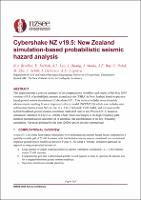| dc.contributor.author | Bradley, Brendon | |
| dc.contributor.author | Tarbali, Karim | |
| dc.contributor.author | Lee, Robin | |
| dc.contributor.author | Huang, Jonney | |
| dc.contributor.author | Motha, Jason | |
| dc.contributor.author | Bae, Sung | |
| dc.contributor.author | Polak, Viktor | |
| dc.contributor.author | Zhu, Melody | |
| dc.contributor.author | Schill, Claudio | |
| dc.contributor.author | Patterson, James | |
| dc.contributor.author | Lagrava, Daniel | |
| dc.date.accessioned | 2020-06-18T13:53:54Z | |
| dc.date.available | 2020-06-18T13:53:54Z | |
| dc.date.issued | 2020-04-22 | |
| dc.identifier.uri | https://repo.nzsee.org.nz/xmlui/handle/nzsee/1730 | |
| dc.description.abstract | This paper presents a concise summary of the computational workflow and results of the May 2019 version (v19.5) of probabilistic seismic hazard analysis (PSHA) in New Zealand based on physics-based ground motion simulations (‘Cybershake NZ’). This version includes several notable advancements resulting from an improved velocity model (NZVM2.03) which now includes nine sedimentary basins across NZ (vs. one in v18.6), a NZ-wide Vs30 model, and revisions to the hybrid broadband ground motion simulation method of Graves and Pitarka (2016) based on simulation validation in Lee et al. (2020) which results in changes to the high-frequency path duration parametrization and removal of empirical site amplification in the low-frequency calculation. Advances planned for the next (2020) version are also summarised. | |
| dc.language.iso | en | |
| dc.publisher | New Zealand Society for Earthquake Engineering | |
| dc.relation.ispartofseries | 2020;110 | |
| dc.subject | Engineering seismology | |
| dc.title | Cybershake NZ v19.5: New Zealand simulation-based probabilistic seismic hazard analysis | |
| dc.type | Article | |

